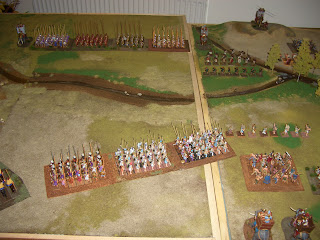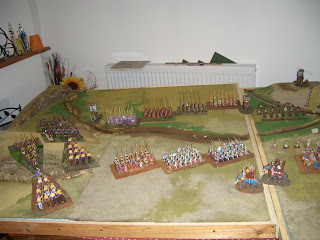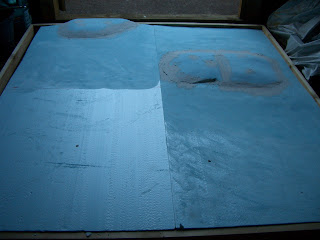Or was it 198 BC, nobody knows. Regardless here is our paltrey attempt to recreate a pivotal moment of Hellenistic history using our own bastardized WAB rules; Mr. Paul Ireland takes the part of Scopas, Ptolemy V's Strategos; I have the dubious honour of stepping into the shoes of Antiochus III.
The forces lined up as follows:
The Ptolemaic right wing with General Scopas, two units of light cavalry, a unit of peltasts in open order, thureophoroi & Aetolian hoplites screened by slingers and archers.
Facing them; Dahae horse archers, Politikoi cavalry, thorakites & thureophoroi screened to the front with archers. The arab levy lurks to one side in the broken ground & an elephant waits in reserve on the hill.
In the centre the Ptolemaic phalanx , Galatians and two African elephants face the Seleucid phalanx flanked by two Indian elephants.
On the left flank two units of Companions face the newly minted Seleucid cataphract arm.
The Seleucid King Antiochus opens the battle by leading his Hetairoi in a charge against the Ptolemaic companions, the Agema cataphracts close up in support. This results in a temporary stalemate as both sides fail to inflict casualties.
In the centre the Seleucid phalanx begins a slow grind forward in line oblique.
A tentative advance onto the hillside occurs on the far wing.
The General Scopas responds with a general advance and a charge of companions into the Seleucid Agema, this too results in stalemate.
In a pivotal moment, the Seleucid heavies rout both units of Companions facing them leaving the Ptolmeic centre hanging in the wind.
Meanwhile over on the other flank the Ptolemaic lights skirmish tentatively forward taking casualties from the horse archers Parthian shot.
The Seleucid King and his Hetairoi follow up their destruction of the Ptolemaic horse with a successful charge into the flank of the phalanx, but with their blown horses cannot follow up quickly enough to destroy it.
The action on the other flank is less decisive as the river crossing slows down the light cavalry. Skirmishing continues in the broken ground and the Seleucid Thorakites occupy the hill.
The Seleucid cavalry continue to play havoc with the Ptolemaic centre rolling up the flanks of the phalanx assisted by the one Elephant. Scopas's Elephants arrive in support of his crumbling troops.
On this wing two charges from the light horse break the Seleucid forces on the hill but crucially depleting their own numbers in the process. A charge from the Galatians ruined a unit of Persian Archers, their follow up into the Arab levy was a disaster as they are swept away in turn.
Having broken another pike phalanx Antiochus continues his blitzkrieg across the board leaving his own phalanx & elephant to deal with their opponents, Ptolemaic elephants hold the other cavalry units in check in the lee of Mount Hermon.
Antiochus arrives on the flank of the Aetolian hoplites and promptly breaks them too.
In another crucial moment the Ptolemaic elephants crush the Seleucid cataphracts & rout the Agema, in the phalanx fight the remaining phalanx come within an ace of breaking the Seleucid line, however they in turn break in the next combat and the battle is lost.
And thats where we finished. The only intact Ptolemaic units being the elephants, and the remnants of the right wing. I've probably omitted a lot of the finer points of detail but in essence we returned a fairly historical result. Each side had a successful right wing and in the centre the Seleucid cavalry rolled up the Ptolemaic phalanx.
It may seem a little one sided but there were points where the result could have been very different, if Paul's right wing could have got into action a little quicker he could have put pressure on my left wing and opened up the flank for exploitation. This would have been particularly serious if his Galatians had broken through the Arab levy, as I expected them to.
In the phalanx clash he came close to breaking my centre, winning the combat by a good margin only to be thwarted by a good break test on my part.
The fight of the heavy cavalry early on was the real killer though, cataphract armour & barding really do make it difficult for wounds to stick.
In the end a good day was had by both of us so all the early mornings and late nights preparing paid off.
An occasional journal chronicling my ongoing forays into the world of roleplaying games, boardgames & tabletop wargames and my continuing lack of success in either of the last two; this is where the lament bit comes in.
Saturday, 23 July 2011
Thursday, 21 July 2011
Panion, 1st Terrain Board Complete.
Finished the first half of the 8x4 ft Panion battlefield this evening:
Both views are looking from the Ptolmeic right wing of the battlefield across the Banias stream toward the Tel Azzaziyat hill in the centre and the Tel Fakhir on the far baseline.
All the groundworks have been laid on the second board, once the florists resin water has set tomorrow evening a final flock & drybrush will take place and we're all set to go for Saturdays refight. That at least is the plan.
Both views are looking from the Ptolmeic right wing of the battlefield across the Banias stream toward the Tel Azzaziyat hill in the centre and the Tel Fakhir on the far baseline.
All the groundworks have been laid on the second board, once the florists resin water has set tomorrow evening a final flock & drybrush will take place and we're all set to go for Saturdays refight. That at least is the plan.
Wednesday, 20 July 2011
...And sneaking along in the drizzle, The Euzonoi.
First up some Arab tribesmen from the dusty interior (of my miniatures drawer), followed by exotic Maotians from the Black sea. I don't know why I bought these from Vendel many years ago, perhaps to mix in with a Celtic warband or to use as vassal infantry for Scythians. Whatever the reason they have a character all of their own and have served in many a previous skirmish line. Note, usefully they carry both javelins & bows.
Next up a couple of small units of Persian archers, from Persia.
Next up a couple of small units of Persian archers, from Persia.
Tuesday, 19 July 2011
Storm Clouds Gather.
As its only a few days until the Panion refight I thought I'd better start to showcase the antagonists.
First up the new fangled heavies of Antiochus III's Seleucid Army:
Here we have the Hetairoi out in front followed by Agema cataphracts (with standard) and line cataphracts, here being represented by some of my new Parthians. The logic here being that the poor old line are equipped with captured armour whilst the fancy dan elites have nice new hellenized gear.
First up the new fangled heavies of Antiochus III's Seleucid Army:
Here we have the Hetairoi out in front followed by Agema cataphracts (with standard) and line cataphracts, here being represented by some of my new Parthians. The logic here being that the poor old line are equipped with captured armour whilst the fancy dan elites have nice new hellenized gear.
Monday, 18 July 2011
Flocked up.
Progress continues Slartyblartfarst like on the terrain for Panion. Flocking up this evening.
I'm not entirely sold on the dark green areas round the junction of the streams, but a light dust over with some lighter winter grass mix should fix that. The dark brown areas are talus scree awaiting a lighter dry brushing.
I'm not entirely sold on the dark green areas round the junction of the streams, but a light dust over with some lighter winter grass mix should fix that. The dark brown areas are talus scree awaiting a lighter dry brushing.
Sunday, 17 July 2011
Scenery progress.
Been busy in the shed today:
The PVA envelop idea seems to be working up to now but I'm taking the precaution of repeating each coat of paint on the rear of the board just to be certain.
A couple of coats of dark brown emulsion have been hastily daubed on and allowed to dry for a few hours and I've just dusted over the top with some lovely British Leyland beige spray paint found in the back of the shed. Will now leave to dry off and then its on with the tack coat & flock.
The PVA envelop idea seems to be working up to now but I'm taking the precaution of repeating each coat of paint on the rear of the board just to be certain.
A couple of coats of dark brown emulsion have been hastily daubed on and allowed to dry for a few hours and I've just dusted over the top with some lovely British Leyland beige spray paint found in the back of the shed. Will now leave to dry off and then its on with the tack coat & flock.
Saturday, 16 July 2011
Out of the Blue.
Started work on the scenery for Mr. Ireland and mine Panion re-fight today using high density styrene foam sourced from Jed & Nadine at Antenociti's Workshop.
Still a way to go but you have to start somewhere. The contours don't show up very well yet as the light blue colour seems to flatten things out somewhat.
Basic shaping was done with a belt sander and an 80 grit belt, very fast but also very messy. It was fortunate that we had a good stiff breeze blowing in Salop today to gently whisk most of the dust away. I did take the added precaution of wearing a decent dust mask 'cos you never know what revolting tack is used in the manufacture of styrene. This was followed by a light rub over with a detail sander with 180 grit to give a good key for the PVA envelope which is tomorrows job.
The PVA envelope, in case you're interested should remove the necesity of glueing the styrene to a heavy ply or MDF base. The theory is that each layer of PVA, paint or whatever applied to the playing surface of the terrain board is mirrored with a layer of PVA added to the reverse face, this way as the glue or paint contracts slightly as it dries the "cupping" effect is counter acted. This according to a friend in the theatrical scenery business works well on large pieces of flat plywood removing the need for extensive stiffening to the rear of the set pieces.
Anyway, check back tomorrow to see if practice matches theory. I bet you're all on tenterhooks.
Still a way to go but you have to start somewhere. The contours don't show up very well yet as the light blue colour seems to flatten things out somewhat.
Basic shaping was done with a belt sander and an 80 grit belt, very fast but also very messy. It was fortunate that we had a good stiff breeze blowing in Salop today to gently whisk most of the dust away. I did take the added precaution of wearing a decent dust mask 'cos you never know what revolting tack is used in the manufacture of styrene. This was followed by a light rub over with a detail sander with 180 grit to give a good key for the PVA envelope which is tomorrows job.
The PVA envelope, in case you're interested should remove the necesity of glueing the styrene to a heavy ply or MDF base. The theory is that each layer of PVA, paint or whatever applied to the playing surface of the terrain board is mirrored with a layer of PVA added to the reverse face, this way as the glue or paint contracts slightly as it dries the "cupping" effect is counter acted. This according to a friend in the theatrical scenery business works well on large pieces of flat plywood removing the need for extensive stiffening to the rear of the set pieces.
Anyway, check back tomorrow to see if practice matches theory. I bet you're all on tenterhooks.
Thursday, 7 July 2011
Look what I found at the back of the cupboard.
It's been a busy couple of weeks at HGA towers, but most of that busyness has been funneled into the day job leaving little time for the painting of lead alloy miniatures, besides which a flair up of an old tendon problem in two digits has turned said activity into too much of a chore for the time being. Consequently the Parthian project is on hold for a few days until things settle down a little. But here below are a few little side projects that have also been tidied up recently.
Three of Terry Pratchett's Nightwatch in their natural environment. Figures by Micro-art Studio, stonework carved from balsa foam & cobbles and bay window by Antenocitis Workshop.
A really old ( circa late 70's ) Hoplite by Al Charles. Quite primitive by todays standards but still plenty of foundation for a tidy paint job. This will in all likelyhood be a nice interlude to look forward to once the 'Thundering Horde" are complete.
Finally "The Box that Sings" a prop for an upcoming Call of Cthulhu game that has been pending for what seems like an age, organising roleplayers to be in one place at one time is like herding cats. This was constructed using a wooden box, plastic card & some of the guts from an old radiogram that I dis-embowelled to turn into a liquer cabinet.
Three of Terry Pratchett's Nightwatch in their natural environment. Figures by Micro-art Studio, stonework carved from balsa foam & cobbles and bay window by Antenocitis Workshop.
A really old ( circa late 70's ) Hoplite by Al Charles. Quite primitive by todays standards but still plenty of foundation for a tidy paint job. This will in all likelyhood be a nice interlude to look forward to once the 'Thundering Horde" are complete.
Finally "The Box that Sings" a prop for an upcoming Call of Cthulhu game that has been pending for what seems like an age, organising roleplayers to be in one place at one time is like herding cats. This was constructed using a wooden box, plastic card & some of the guts from an old radiogram that I dis-embowelled to turn into a liquer cabinet.
Subscribe to:
Posts (Atom)






































